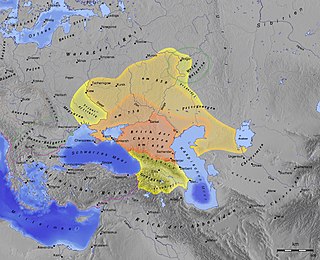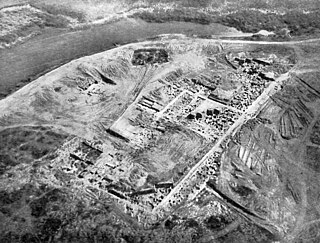Related Research Articles

The Khazars were a semi-nomadic Turkic people that in the late 6th-century CE established a major commercial empire covering the southeastern section of modern European Russia, southern Ukraine, Crimea, and Kazakhstan. They created what for its duration was the most powerful polity to emerge from the break-up of the Western Turkic Khaganate. Astride a major artery of commerce between Eastern Europe and Southwestern Asia, Khazaria became one of the foremost trading empires of the early medieval world, commanding the western marches of the Silk Road and playing a key commercial role as a crossroad between China, the Middle East and Kievan Rus'. For some three centuries the Khazars dominated the vast area extending from the Volga-Don steppes to the eastern Crimea and the northern Caucasus.

Sarkel was a large limestone-and-brick fortress in the present-day Rostov Oblast of Russia, on the left bank of the lower Don River.
Barjik was a Khazar prince who flourished in the late 720s. He is described by al-Tabari as "the son of the Khagan"; his exact status and position is unknown though he may have been the Bek.
Bulan was a Khazar king who led the conversion of the Khazars to Judaism. His name means "elk" or "hart" in Old Turkic. The date of his reign is unknown, as the date of the conversion is hotly disputed, though it is certain that Bulan reigned some time between the mid-8th and the mid-9th centuries. Nor is it settled whether Bulan was the Bek or the Khagan of the Khazars.
The "Schechter Letter" was discovered in the Cairo Geniza by Solomon Schechter.
Joseph ben Aaron was king of the Khazars during the 950s and 960s. Joseph was the son of Aaron II, a Khazar ruler who defeated a Byzantine-inspired war against Khazaria on numerous fronts. Joseph's wife was the daughter of the king of the Alans.
A purported Khazar ruler of the late tenth century CE who ruled over a Khazar successor-state in the Taman region. David is mentioned in a single document dated AM 4746 which contains a reference to "our lord David, Prince of the Khazars, who lives in Taman." The document in question is of uncertain authenticity, as it passed through the hands of Abraham Firkovich, who on occasion forged documents and inscriptions.
A Khazar Jewish general mentioned in the Schechter Letter. Pesakh was military commander of the region around the Strait of Kerch who defeated the armies of the Rus' prince "HLGW" around the year 941 in the Taman region. His title is given as Baliqchi which translates roughly as "Fisherman" ; scholars have hypothesized that this was a naval rank within the Khazar military.
The Battle of Marj Ardabil or the Battle of Ardabil was a battle fought on the plains surrounding the city of Ardabil in northwestern Iran in AD 730. A Khazar army led by Barjik, the son of the Khazar khagan, invaded the Umayyad provinces of Jibal and Iranian Azerbaijan in retaliation for Caliphate attacks on Khazaria during the course of the decades-long Khazar-Arab War of the early 8th century.

The Thirteenth Tribe is a 1976 book by Arthur Koestler, in which the author advances the thesis that Ashkenazi Jews are not descended from the historical Israelites of antiquity, but from Khazars, a Turkic people. Koestler hypothesized that the Khazars migrated westwards into Eastern Europe in the 12th and 13th centuries when the Khazar Empire was collapsing.
Alp Ilutuer was the Ilutuer of the North Caucasian Huns during the 680s CE.
Hanukkah or Chanukkah ben Obadiah was a hypothetical Khazar ruler who probably reigned during the mid to late ninth century CE. Hanukkah was the son of Obadiah and succeeded his nephew Manasseh I to the throne. No contemporary records from his reign survive; however, he is known from the Khazar Correspondence between Hisdai ibn Shaprut and the Khazar king Joseph. As with the other Bulanids, it is unclear whether Hanukkah was a khagan or a khagan bek; however, most modern scholars lean towards the latter possibility. Historical authenticity and accuracy of the only document mentioning his name has been questioned.
Hezekiah ben Obadiah was a hypothetical ruler of the Khazars, probably in the mid ninth century CE. He was the son of Obadiah, the descendant of Bulan who brought rabbinical scholars to and built yeshivot in Khazaria. Nothing is known about Hezekiah's reign and the historical authenticity and accuracy of the only document mentioning his name has been questioned. As with other Bulanid rulers, it is unclear whether Hezekiah was Khagan or Khagan Bek of the Khazars, although the latter is more likely.
Menasseh ben Hezekiah was a hypothetical Turkic ruler of the Khazars mentioned in the Khazar Correspondence. He probably reigned in the mid to late ninth century CE. He was the son of Hezekiah, the son of Obadiah. Little is known about his reign. Historical authenticity and accuracy of the only document mentioning his name has been questioned. As with other Bulanid rulers, it is unclear whether he was Khagan or Khagan Bek of the Khazars, although the latter is more likely.
Isaac ben Hanukkah was a hypothetical Jewish ruler of the Khazars mentioned in the Khazar Correspondence. He probably reigned in the mid to late ninth century CE. Little is known about his reign. As with other Bulanid rulers, it is unclear whether Isaac was Khagan or Khagan Bek of the Khazars, although the latter is more likely. He was succeeded by his son Zebulun. Historical authenticity and accuracy of the only document mentioning his name has been questioned.
Zebulun or Zevulun ben Isaac was a hypothetical Jewish Turkic ruler of the Khazars mentioned in the Khazar Correspondence. He probably reigned in the late ninth century CE. Little is known about Zebulun's reign. As with other Bulanid rulers, it is unclear whether he was Khagan or Khagan Bek of the Khazars, although the latter is more likely. Historical authenticity and accuracy of the only document mentioning his name has been questioned.
The Battle of Balanjar was fought around 732 near the Khazar city of Balanjar. The Umayyad army, commanded by the prince Maslamah ibn Abd al-Malik, was victorious and advanced on towards Samandar.
The Mandgelis Document or Mandgelis Letter was a letter in Hebrew dated AM 4746 (985–986). It refers to "our lord David, the Khazar prince" who lived in Taman. The letter said that this David was visited by envoys from Kievan Rus to ask about religious matters. This consultation may have been connected to the conversion of Vladimir I of Kiev which took place during roughly the same time period. Taman was a principality of Kievan Rus around 988, so this successor state may have been conquered altogether. The authenticity of this letter has however been questioned by such scholars as D. M. Dunlop, as it passed through the hands of Abraham Firkovich, who is known to have forged documents and inscriptions on occasion.
Pax Khazarica is a historiographical term, modeled after the original phrase Pax Romana, applied to the period during which the Khazar Khaganate dominated the Pontic steppe and the Caucasus Mountains. During this period, Khazar dominion over vital trans-Eurasian trade routes facilitated travel and trade between Europe and Asia by such groups as the Radhanites and the early Rus. The originator of the term is unknown but it was in use by scholars as early as the nineteenth century.
The Khazar hypothesis of Ashkenazi ancestry, often called the Khazar myth by its critics, is a largely abandoned historical hypothesis. The hypothesis postulated that Ashkenazi Jews were primarily, or to a large extent, descended from Khazars, a multi-ethnic conglomerate of mostly Turkic peoples who formed a semi-nomadic khanate in and around the northern and central Caucasus and the Pontic–Caspian steppe. The hypothesis also postulated that after collapse of the Khazar empire, the Khazars fled to Eastern Europe and made up a large part of the Jews there. The hypothesis draws on some medieval sources such as the Khazar Correspondence, according to which at some point in the 8th–9th centuries, a small number of Khazars were said by Judah Halevi and Abraham ibn Daud to have converted to Rabbinic Judaism. The scope of the conversion within the Khazar Khanate remains uncertain, but the evidence used to tie the Ashkenazi communities to the Khazars is meager and subject to conflicting interpretations.
References
- Dunlop, Douglas M. The History of the Jewish Khazars, Princeton, N.J.: Princeton University Press, 1954.
- Hundert, Gershon David. "Jewish Poland: Legends of Origin, Ethnopoetics and Legendary Chronicles by Haya Bar-Itzhak" The Jewish Quarterly Review, New Ser., Vol. 92, No. 1/2 (Jul. - Oct., 2001), pp. 222–226
- Kraushar, A. Historya Zydów w Polsce
- Sternberg. Gesch. der Juden in Polen
![]() This article incorporates text from a publication now in the public domain : Singer, Isidore; et al., eds. (1901–1906). "Abraham Prochownik". The Jewish Encyclopedia . New York: Funk & Wagnalls.
This article incorporates text from a publication now in the public domain : Singer, Isidore; et al., eds. (1901–1906). "Abraham Prochownik". The Jewish Encyclopedia . New York: Funk & Wagnalls.